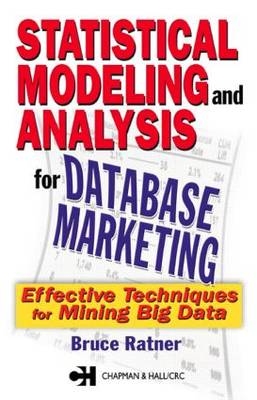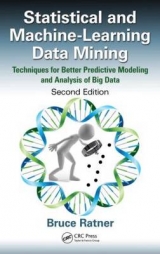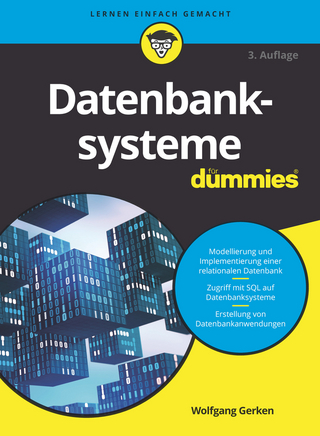
Statistical Modeling and Analysis for Database Marketing
Crc Press Inc (Verlag)
978-1-57444-344-8 (ISBN)
- Titel erscheint in neuer Auflage
- Artikel merken
Traditional statistical methods are limited in their ability to meet the modern challenge of mining large amounts of data. Data miners, analysts, and statisticians are searching for innovative new data mining techniques with greater predictive power, an attribute critical for reliable models and analyses.
Statistical Modeling and Analysis for Database Marketing: Effective Techniques for Mining Big Data delivers a collection of successful database marketing methodologies for big data. This compendium solves common database marketing problems by applying new hybrid modeling techniques that combine traditional statistical and new machine learning methods. The book delivers a thorough analysis of these cutting-edge techniques, which include non-statistical machine learning and genetic intelligent hybrid models.
By following the step-by-step procedures detailed in the text, database marketing professionals can learn how to apply the proper statistical techniques to any database marketing challenge. The practical case studies and examples provided involve real problems and real data, and are taken from a variety of industries, including banking, insurance, finance, retail, and telecommunications.
Contents Introduction
The Personal Computer and Statistics
Statistics and Data Analysis
EDA
The EDA Paradigm
EDA Weaknesses
Small and Big Data
Data Mining Paradigm
Statistics and Machine Learning
Statistical Learning
References
Two Simple Data Mining Methods for Variable Assessment
Correlation Coefficient
Scatterplots
Data Mining
Smoothed Scatterplot
General Association Test
Summary
References
Logistic Regression: The Workhorse of Database Response Modeling
Logistic Regression Model
Case Study
Logits and Logit Plots
The Importance of Straight Data
Re-expressing for Straight Data
Straight Data for Case Study
Techniques When Bulging Rule Does Not Apply
Re-expressing MOS_OPEN
Assessing the Importance of Variables
Important Variables for Case Study
Relative Importance of the Variables
Best Subset of Variables for Case Study
Visual Indicators of Goodness of Model Predictions
Evaluating the Data Mining Work
Smoothing a Categorical Variable
Additional Data Mining Work for Case Study
Summary
Ordinary Regression: The Workhorse of Database Profit Modeling
Ordinary Regression Model
Illustration
Mini Case Study
Important Variables for Mini Case Study
Best Subset of Variable for Case Study
Summary
CHAID for Interpreting a Logistic Regression Model
Logistic Regression Model
Database Marketing Response Model Case Study
CHAID
Multivariable CHAID Trees
CHAID Market Segmentation
CHAID Tree Graphs
Summary
The Importance of the Regression Coefficient
The Ordinary Regression Model
Four Questions
Important Predictor Variables
P-values and BIG Data
Returning to Question #1
Predictor Variable’s Effect On Prediction
The Caveat
Returning to Question #2
Ranking Predictor Variables By Effect On Prediction
Returning to Question #3
Returning to Question #46.12 Summary
Reference
The Predictive Contribution Coefficient: A Measure of Predictive Importance
Background
Illustration of Decision Rule, Predictive Contribution Coefficient
Calculation of Predictive Contribution Coefficient
Extra Illustration of Predictive Contribution Coefficient
Summary
Reference
CHAID for Specifying a Model with Interaction Variables
Interaction Variables
Strategy for Modeling with Interaction Variables
Strategy Based on the Notion of a Special Point
Example of a Response Model with an Interaction Variable
CHAID for Uncovering Relationships
Illustration of CHAID Specifying a Model
An Exploratory Look
Database Implication
Summary
Reference
Market Segment Classification Modeling with Logistic Regression
Binary Logistic Regression
Polychotomous Logistic Regression Model
Model Building With PLR
Market Segmentation Classification Model
Summary
CHAID as a Method for Filling in Missing Values
Introduction to the Problem of Missing Data
Missing-data Assumption
CHAID Imputation
Illustration
CHAID Most-likely Category Imputation for a Categorical Variable
Summary
Reference
Identifying Your Best Customers: Descriptive, Predictive and Look-alike Profiling
Some Definitions
Illustration of a Flawed Targeting Effort
Well-Defined Targeting Effort
Predictive Profiles
Continuous Trees
Look-alike Profiling
Look-alike Tree Characteristics
Summary Assessment of Database Marketing Models
Accuracy for Response Model
Accuracy for Profit Model
Decile Analysis and Cum Lift for Response Model
Decile Analysis and Cum Lift for Profit Model
Precision for Response Model
Construction of SWMAD
Separability for Response and Profit Models
Guidelines for Using Cum Lift, HL/SWMAD and CV
Summary
Bootstrapping in Database Marketing: A New Approach for Validating Models
Traditional Model Validation
Illustration
Three Questions
The Bootstrap
How to Bootstrap
Bootstrap Decile Analysis Validation
Another Question
Bootstrap Assessment of Model Implementation Performance
Bootstrap Assessment of Model Efficiency
Summary
Reference Visualization of Database Models
Brief History of the Graph
Star Graph Basics
Star Graphs for Single Variables
Star Graphs for Many Variables Considered Jointly
Profile Curves Method
Illustration
Summary
SAS Code for Star Graphs for Each Demographic Variable about the Deciles SAS Code for Star Graphs for Each Decile About the Demographic Variables
SAS Code for Profile Curves: All Deciles
Reference
Genetic Modeling in Database Marketing: The GenIQ Model
What Is Optimization?
What Is Genetic Modeling
Genetic Modeling: An Illustration
Parameters for Controlling a Genetic Model Run
Genetic Modeling: Strengths and Limitations
Goals of Modeling in Database Marketing
The GenIQ Response Model
The GenIQ Profit Model
Case Study-Response Model
Case Study-Profit Model
Summary
Reference
Finding the Best Variables for Database Marketing Models
Background
Weakness in the Variable Selection Methods
Goals of Modeling in Database Marketing
Variable Selection with GenIQ
Nonlinear Alternative to Logistic Regression Model
Summary
Reference Interpretation of Coefficient-free Models
The Linear Regression Coefficient
Illustration for the Simple Ordinary Regression Model
The Quasi-Regression Coefficient for Simple Regression Models
Partial Quasi-RC for the Everymodel
Quasi-RC for a Coefficient-free Model
Summary
| Erscheint lt. Verlag | 28.5.2003 |
|---|---|
| Zusatzinfo | 71 equations; 118 Tables, black and white; 150 Illustrations, black and white |
| Verlagsort | Bosa Roca |
| Sprache | englisch |
| Maße | 156 x 235 mm |
| Gewicht | 635 g |
| Themenwelt | Mathematik / Informatik ► Informatik ► Datenbanken |
| Mathematik / Informatik ► Mathematik ► Angewandte Mathematik | |
| Wirtschaft ► Betriebswirtschaft / Management ► Marketing / Vertrieb | |
| ISBN-10 | 1-57444-344-5 / 1574443445 |
| ISBN-13 | 978-1-57444-344-8 / 9781574443448 |
| Zustand | Neuware |
| Haben Sie eine Frage zum Produkt? |
aus dem Bereich



